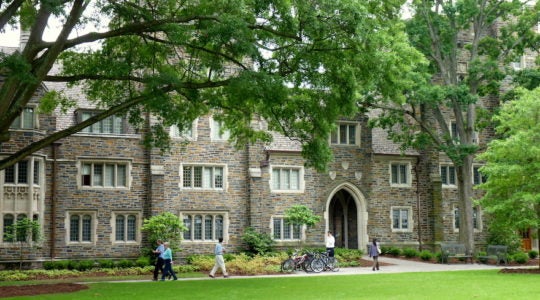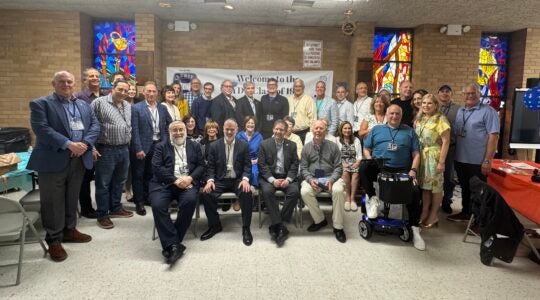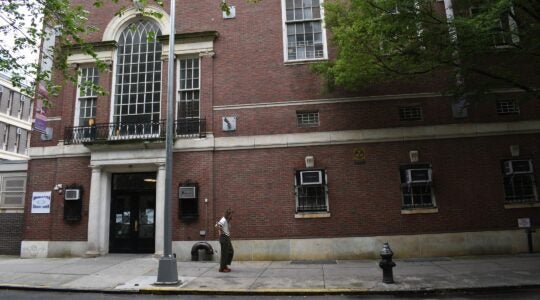A refugee from Nazi Germany who spent much of World War II in Shanghai and came to the United States in 1947, Claus Hirsch was scanning some wartime photographs one recent day — and he spotted a familiar face.
Hirsch, a retired financial analyst who has served as a volunteer for a year and a half at the Midtown offices of the American Jewish Joint Distribution Committee, typing names from old JDC lists into a new database, was asked to look at some pictures taken in the Shanghai Ghetto, where some 20,000 European Jews settled during the war.
Hirsch, his parents and a brothers, were among those Jews.
On a computer screen, in a photo that is part of a newly launched JDC website making thousands of documents and pictures available for the first time to the wider public, Hirsch recognized a photo of a gym class in a Shanghai courtyard. The photo shows dozens of Jewish children, in neat rows, standing with their arms wide apart.
“I knew I was there,” one of the kids in the gym class, Hirsch said.
Eventually, he found his image in the picture, in a back row.
As part of a “Recognize Someone?” feature of the website, which went online last week and allows users to identify the mostly unidentified individual faces in the photographs, users can add a “tag,” available by clicking on a face. Hirsch added a tag to his name. And, grateful for the chance to see himself in a long-forgotten picture, Hirsch contributed one of his own photos — of him at 12 standing on a Shanghai street — to the JDC’s online collection from 14 countries.
Which is the purpose of the new site, called Our Shared Legacy (jdc.org/sharedlegacy). Our Shared Legacy is an expansion of a digitizing and cataloging project that was designed to open the JDC’s Glogal Archives — previously available only to people willing to comb through boxes of physical documents and photos — to anyone with a computer.
“Now, thanks to technology,” says Steven Schwager, the JDC’s CEO, “survivors and their descendants can directly engage with our shared history. Whether you were a little Jewish child we aided in Barcelona or one of the Jews we supported in Displaced Persons Camps after the war, by putting faces, names and stories together, you will benefit generations to come.”
Our Shared Legacy began the same week that the World Memory Project, a joint initiative of the U.S. Holocaust Memorial Museum and Ancestry.com that is billed as the world’s largest online database of information on Holocaust victims, was announced. The World Memory Project (worldmemoryproject.org) offers archival materials on both Jews and non-Jews who were targeted for persecution by the Third Reich. Another newly unveiled online resource for 20th-century Jewish history is JTA’s Digital Archive of news articles from 1917 on. The JTA archive, opened this month, include extensive coverage of the Holocaust.
The JDC is promoting its website among survivors’ organizations, Jewish federations and other Jewish groups.
In the first few days after it was launched, “tens of thousands” of individuals — presumably historians and researchers, Holocaust survivors and their relatives, people interested in finding neighbors from the Old Country — visited the site, says Michael Geller, JDC’s media relations manager.
Several JDC staffers were able to find relatives’ names on the website, says Naomi Barth, who coordinates the group’s indexing project.
The site also allows users to tell their own stories (the Joint was one of the chief sources of aid to endangered Jews through the wartime period), find their name or the name of a loved one in a database of a half-million names (the JDC operated then in Shanghai, Barcelona, Kobe, Vilna, Munich, Vienna, Australia and South America), and support the agency’s work (through a Family Legacy feature).
Employing “fuzzy results,” which recognizes a variety of spellings of names, people can be found on the website even if their spelling does not agree with the proper version, Geller says.
The website will enable the JDC to expand its history, says Gideon Taylor, the humanitarian organization’s assistant vice president. Today, he says, the “helped” can help the “helpers” — the wartime testimonies contributed by survivors will add to the JDC extant records. “Tell us your DP stories — this will fill in the blanks.”
Hirsch’s family received assistance from the Joint while in Shanghai, in the square-mile Restricted Sector for Stateless Refugees, under Japanese control, where people without a visa or passport were allowed to enter.
A veteran of the U.S. Army and graduate the University of Pennsylvania’s Wharton School of Business, he decided to volunteer for the Joint, when the opportunity was announced last year at a meeting of the Jewish Genealogical Society, as a way “to repay” the JDC.
Several other members of the Society also decided to become volunteers, says Hirsch, 76, who lives on the Upper East Side.
Some day this week, Hirsch will be back at the Joint headquarters, typing at a keyboard, looking at more old photographs.
E-mail: steve@jewishweek.org
The New York Jewish Week brings you the stories behind the headlines, keeping you connected to Jewish life in New York. Help sustain the reporting you trust by donating today.




